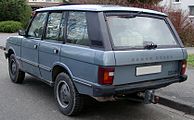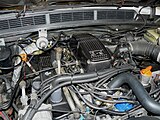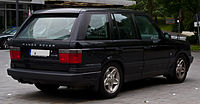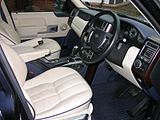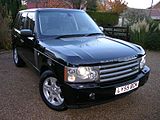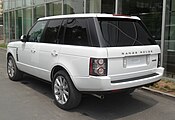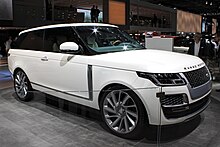Range Rover
| Land Rover Range Rover | |
|---|---|
| Production period: | since 1970 |
| Class : | Off-road vehicle |
| Body versions : | Station wagon |
The Range Rover is a SUV of the upper class of Land Rover , which was introduced in the summer of 1970 in the market and will be offered in the fourth generation since the fall of the 2012th
The Range Rover still met the design criteria of an off-road vehicle until 2002 . From the third generation developed by BMW, the specifications correspond to those of an SUV. The first models of the Range Rover pioneered sport utility vehicles, but, unlike the majority of these vehicles, were highly suitable for off-road use . The Range Rover Evoque , Range Rover Sport and Range Rover Velar are also referred to as Range Rover .
Make or model
Just like the Land Rover and the Freight Rover , the Range Rover was initially more of a model from the British manufacturer Rover than its own brand. The spin-off and restructuring within British Leyland laid the foundation for the separation of Rover (part of the Austin Rover Group) and Land Rover and Range Rover (part of the Land Rover Leyland Group). Since then, the Range Rover can be seen as a model alongside the Land Rover Series III under the Land Rover brand.
Jaguar Land Rover is part since 2008 as a subsidiary of India's Tata Motors . Under the current owner, a brief establishment of the “Range Rover” brand became apparent. Signs of this were the two areas of the joint web presence: Range Rover, Range Rover Sport and Range Rover Evoque on the one hand and Land Rover Defender , Land Rover Freelander 2 and Land Rover Discovery 4 on the other. The company policy changed again in 2013, as the Land Rover logo was included in the radiator grille for the first time on the Range Rover Evoque and the Range Rover (MK IV) with clearly visible Land Rover logos in the radiator grille, on the hub covers the wheels as well as on the trunk lid. The correct model name for a Range Rover Sport, for example, is "Land Rover Range Rover Sport".
Range Rover / Classic (1970-1996)
| 1st generation | |
|---|---|
|
Range Rover three-door (1970–1985) |
|
| Production period: | 1970-1995 |
| Body versions : | Station wagon |
| Engines: |
Otto engines : 3.5-4.2 liters (93-149 kW) Diesel engines : 2.4 liters (78 kW) |
| Length: | 4445-4648 mm |
| Width: | 1780 mm |
| Height: | 1780 mm |
| Wheelbase : | 2530-2743 mm |
| Empty weight : | 1892-2075 kg |
The first Range Rover was officially presented on June 17, 1970 and was manufactured from July 1970 to February 1996, although its technology was constantly being further developed. Its permanent all-wheel drive , coil suspension and, last but not least, the 3.5-liter V8 engine revolutionized the off-road vehicle market. The Range Rover was already seen as a model for a number of other luxurious off-road vehicles in the 1970s, including the Monteverdi Safari and the Felber Oasis .
The vehicle was initially designed as a pure three-door model. In the 1970s, Rover was not financially able to develop a five-door variant itself, although there were corresponding requests from customers.
Between 1980 and 1982, the Swiss sports car manufacturer Monteverdi developed and built a five-door version on behalf of British Leyland , which was officially sold in some countries through Rover dealers under the name Range Rover Monteverdi. A total of 167 copies were made, most of which stayed in Switzerland. A number of Monteverdi conversions also made it to Great Britain, and the British royal family took over two vehicles in their own fleet. The question of whether the Range Rovers were rebuilt in Monteverdi's workshops in Basel or whether - as was common at Monteverdi at the time - the work was carried out by Carrozzeria Fissore or another body shop in Northern Italy has not yet been clarified . There is no information on this in the Monteverdi documents.
From August 1981 Range Rover produced the five-door version itself. Essential elements of the Monteverdi construction were adopted.
In October 1985 the Range Rover was slightly modified visually and technically. The engine received an intake manifold injection .
In November 1988, the displacement of the aluminum engine block was increased from 3.5 liters to 3.9 liters.
In September 1992, the LSE was introduced, a 203 mm longer version with a displacement increased to 4.2 liters and air suspension . Like the Land Rover Series III at the time , the Range Rover was based on a ladder frame with two rigid axles spaced 2.54 meters (100 inches) apart, a proven and robust construction.
Despite its comfortable, optionally also luxurious interior and its roadworthy appearance, the Range Rover "Classic" is a suitable off-road vehicle even without modifications. The long suspension travel of the axles and the relatively high ground clearance ensure traction even under difficult conditions. The high-torque 3.9-liter Rover V8 makes 127 kW (173 hp) at 4,500 min -1 and, together with the lock of the longitudinal differential and the reduction of high traction performance.
At the end of 1995 production of the first generation ran out. Most recently it remained in the program as “Classic” alongside the second edition presented in spring 1994.
Range Rover (P38A / LP, 1994-2002)
| 2nd generation | |
|---|---|
|
Range Rover 4.6 HSE (1994-1998) |
|
| Production period: | 1994-2002 |
| Body versions : | Station wagon |
| Engines: |
Otto engines : 4.0–4.6 liters (136–165 kW) Diesel engine : 2.5 liters (100 kW) |
| Length: | 4712 mm |
| Width: | 1890 mm |
| Height: | 1819 mm |
| Wheelbase : | 2745 mm |
| Empty weight : | 2115-2340 kg |
Land Rover began developing the successor to the Range Rover as early as 1988. Since its introduction in the summer of 1970, this had increasingly moved in the direction of the luxury segment, at the same time the new Discovery was almost completed and it was foreseeable that the original vehicle concept of the Classic would sooner or later have to be modernized. The project was first run internally under the name Pegasus (a reference to the air suspension), later as Project 38A (this was the name of the building in which the project participants worked).
George Thomson was Land Rover's Styling Director at the time, and his job was to translate the original design into a contemporary design language that would appeal to both existing and new customers. Various designs were made, with the renowned offices Pininfarina , Italdesign Giugiaro , Bertone , John Heffernan and Ken Greenley involved in the process. In the final selection round, the design by Bertone and the proposal from the Land Rover design department, of which 1: 1 models were manufactured. Intensive market research and acceptance tests with participants from several countries led to the realization that the Bertone design was not clearly recognizable as a Range Rover, so that Thomson's team decided to use the design.
On September 29, 1994 the "New Range Rover" was presented to the public. It was the first newly presented model of the Rover Group after the takeover by BMW, and it was to remain the model in which Wolfgang Reitzle showed the greatest interest in the years that followed, along with the Mini .
In June 1998 a small facelift was carried out, which could be seen from the outside by the white turn signal glasses in front and the darkened rear lights.
Engines
Apart from various special models, there were mainly the following three engine and two equipment variants:
- SE: 4.0-liter V8 petrol engine with 136–140 kW (185–190 hp; 06 / 1994–01 / 2002)
- HSE: 4.6-liter V8 petrol engine with 160–165 kW (218–224 hp; 06 / 1994–01 / 2002)
- DSE: 2.5-liter R6 diesel with 100 kW (136 PS, BMW M51 D25; 06 / 1994–01 / 2002)
The V8 variants were further developments based on the proven Rover V8 block, which debuted in the Buick Special in 1960, while a specially adapted version of the 2.5-liter M51 turbodiesel engine from BMW was used in the diesel models.
The P38A is also based on a ladder frame, in this case with rigid axles each guided by trailing arms and a Panhard rod. All models have electronically controlled air suspension, which allows the ground clearance to be adapted to the respective operating conditions. The P38A was built from mid-1994 to early 2002, with the last vehicles being declared as model year '02.
The first vehicle from series production in June 1994 had the serial number MA300190.
Range Rover (LM / L322, 2002-2012)
| 3rd generation | |
|---|---|
|
Range Rover (2002-2005) |
|
| Production period: | 2002–2012 |
| Body versions : | Station wagon |
| Engines: |
Petrol engines : 4.2–5.0 liters (210–375 kW) Diesel engines : 3.0–4.4 liters (130–230 kW) |
| Length: | 4972 mm |
| Width: | 2034 mm |
| Height: | 1988 mm |
| Wheelbase : | 2880 mm |
| Empty weight : | 2684-2858 kg |
The third generation of the Range Rover (code: L322) was launched on January 11, 2002. The main changes were the self-supporting body and the independent suspension . In terms of the visual appearance, care was taken to restore the typical appearance of the Range Rover. It turned out to be problematic that the Range Rover L322 was developed by BMW (BMW development code L30), but the Land Rover company fell when the Rover was sold to Ford. BMW undertook to supply engines and essential components until further notice, but the units no longer took part in further technical development.
For this reason, technical innovations (partly from the new Discovery 3 ) were introduced just two years after the market launch . The BMW V8 was replaced by a Jaguar unit (optionally with a supercharged compressor ), the five-speed automatic transmission with a six-speed automatic transmission and the Torsen lock in the central differential with an electronically controlled multi-plate clutch.
Between spring 2006 and autumn 2010, the Range Rover was also offered with a 3.6-liter V8 biturbo diesel engine with 200 kW (272 hp) and 640 Nm torque, which was developed jointly with PSA Peugeot Citroën .
At the end of 2007, the naturally aspirated V8 engine was discontinued, so that only the V8 Supercharged and the TDV8 were offered.
Model maintenance
2005
In May 2005, a mainly technical facelift was carried out in which modified engines were used. The basic V8 now developed 224 instead of 210 kW. In addition, a 4.2 l V8 with supercharger expanded the range, developing an output of 291 kW.
2009
In September 2009 the Range Rover underwent a facelift. In addition to the interior and the technology, the exterior design was also slightly revised. The revised model can be recognized by its new headlights and new LED rear lights as well as a new radiator grille and bumper.
The displacement of the V8 Supercharged was increased to five liters and now developed 375 kW.
In September 2010 a new 4.4-liter V8 diesel was introduced, the output increased to 230 kW / 313 PS and 700 Nm combined with an 8-speed automatic from ZF.
Production of the third Range Rover ended in autumn 2012. The successor was presented at the Paris Motor Show.
Technical specifications
| Parameters | V8 | V8 1 | V8 supercharged | TD6 | TDV8 | |||
|---|---|---|---|---|---|---|---|---|
| Construction period | 02 / 2002–05 / 2005 | 05/2005–11/2007 | 08/2009 - 08/2012 | 05 / 2005-07 / 2009 | 08/2009 - 08/2012 | 02 / 2002-03 / 2006 | 04 / 2006-10 / 2010 | 07/2010-08/2012 |
| Engine characteristics | ||||||||
| Engine type | BMW M62B44TÜ | Jaguar AJ41 | Jaguar AJ133 | Jaguar AJ34S | Jaguar AJ133 | BMW M57D30 | PSA DT17 | |
| Engine type | V8 petrol engine | R6 diesel engine | V8 diesel engine | |||||
| Mixture preparation | Manifold injection (AJ133 direct injection ) | Common rail direct injection | ||||||
| Engine charging | - | compressor | turbocharger | Biturbo | ||||
| Displacement | 4398 cc | 4394 cc | 5000 cc | 4197 cc | 5000 cc | 2926 cc | 3628 cc | 4367 cc |
| Max. power | 210 kW (286 hp) at 5400 rpm |
224 kW (305 hp) at 5750 rpm |
276 kW (375 hp) at 6500 rpm |
291 kW (396 hp) at 5750 rpm |
375 kW (510 hp) at 6000-6500 rpm |
130 kW (177 hp) at 4000 rpm |
200 kW (272 hp) at 4000 rpm |
230 kW (313 hp) at 4000 rpm |
| Max. Torque | 440 Nm at 3600 rpm |
440 Nm at 4000 rpm |
510 Nm at 3500 rpm |
550 Nm at 3500 rpm |
625 Nm at 2500-5500 rpm |
390 Nm at 2000 rpm |
640 Nm at 2000 rpm |
700 Nm at 1500-3000 rpm |
| Power transmission | ||||||||
| Drive, as standard | all wheel drive | |||||||
| Gearbox, as standard | 5-speed automatic transmission | 6-speed automatic transmission | 5-speed automatic transmission | 6-speed automatic transmission | 8-speed automatic transmission | |||
| Readings | ||||||||
| Top speed | 208 km / h | 205 km / h | 210 km / h | 225 km / h | 179 km / h | 200 km / h | 210 km / h | |
|
Acceleration, 0-100 km / h |
9.2 s | 8.7 s | 7.5 s | 7.7 s | 6.2 s | 13.6 s | 9.2 s | 7.8 s |
|
Fuel consumption over 100 km (combined) |
16.2 l super | 14.9 l super | 16.8 l super | 16.0 l super | 14.9 l super | 11.3 l diesel | 11.1 l diesel | 9.4 l diesel |
|
CO 2 emissions (combined) |
389 g / km | 352 g / km | 396 g / km | 376 g / km | 348 g / km | 299 g / km | 294 g / km | 253 g / km |
|
Emission standard according to EU classification |
Euro 3 | Euro 4 | - | Euro 4 | 5 euro | Euro 3 | Euro 4 | 5 euro |
Range Rover (LG / L405, since 2012)
| 4th generation | |
|---|---|
|
Range Rover (since 2012) |
|
| Production period: | since 2012 |
| Body versions : | Station wagon |
| Engines: |
Otto engines : 3.0–5.0 liters (294–416 kW) Diesel engines : 3.0–4.4 liters (190–257 kW) Otto hybrid : 2.0 liters (297 kW) Diesel hybrid : 3, 0 liters (250–260 kW) |
| Length: | 4999-5199 mm |
| Width: | 1983-1998 mm |
| Height: | 1835-1840 mm |
| Wheelbase : | 2922-3120 mm |
| Empty weight : | 2215-2671 kg |
| Stars in the Euro NCAP - Crash Test (2012) |
|
The fourth generation of the Range Rover was first presented on September 6, 2012 at the Paris Motor Show as the Range Rover Parigi Concept . Series production started just a few days later. The design studio and body construction company Vercarmodel Saro was commissioned for the development .
The vehicle has been completely redesigned. As a special feature, the Range Rover now has a monocoque body made of aluminum , which is 150 kg lighter than the sheet steel body of the previous model. These and other lightweight construction measures, including on the chassis, lead to a curb weight of the basic model that is up to 420 kilograms lower. In addition, when designing the headlights in this vehicle, a headlight “signature” was created for the first time through the combination of LEDs and light guides, which gives the Range Rover a unique and individual look. This is in normal operation as daytime running light and is dimmed a little at night or when the low beam is switched on and takes over the function of the parking light. For the first time, the Range Rover can also be ordered in two wheelbases and with a two-seater rear bench that is divided by a center console. This represents an extension of the front center console and offers the occupants in the rear options for operating the rear climate zones, the massage function, seat heating and seat air conditioning, as well as an optional cooled storage compartment under the armrest and a remote control and connections for the optional rear entertainment system.
As a result of this weight reduction, a six-cylinder diesel engine is used again for the first time since 2006, and its performance corresponds to that of the previous TDV8 Range Rover.
Terrain characteristics
The fourth generation of the Range Rover has further improved off-road capabilities. This is not only due to the lower weight, but also to a modified intake air duct and a completely newly developed air suspension. This enables a wading depth of 90 cm (predecessor: 70 cm) and 30 cm ground clearance . A fully automatic all-wheel drive system (Terrain Response 2 Auto) is also available for the first time . With the previous drive concept, it was possible to determine which surface you were on by choosing a special drive program. In contrast to this, by monitoring the slip on individual wheels and processing further signals from corresponding sensors, the appropriate program is selected independently. An electronic rear axle differential lock is available as an option, which, together with the standard two-stage reduction gear, provides propulsion in situations in which a rear wheel is no longer in contact with the ground.
Since the Range Rover is no longer built on a ladder frame as it was originally , the new self-supporting body has been designed to be more rigid. Even with maximum axle articulation, it deforms so little that all doors and the tailgate can be opened and closed again.
Equipment lines
For the Range Rover, the equipment lines HSE , Vogue and Autobiography are available for the German market , which build on each other and, depending on the choice of line, already contain a wealth of various options as standard, with HSE forming the basis and Autobiography a multitude of additional customization options via special paints and Offers leather colors.
Technical specifications
| Parameters | P400 | V8 supercharged | V8 Supercharged SVAutobiography | V8 Supercharged SVAutobiography 2 | TDV6 | SDV6 | D300 | D350 | SDV8 | P400e | SDV6 hybrid | ||
|---|---|---|---|---|---|---|---|---|---|---|---|---|---|
| Construction period | since 07/2019 | 08 / 2012–10 / 2017 | since 01/2018 | 01 / 2016-10 / 2017 | since 01/2018 | 08 / 2012–05 / 2018 | 08 / 2018–07 / 2020 | since 07/2020 | 08 / 2012–07 / 2020 | since 01/2018 | 04/2014–07/2015 | 08 / 2015–03 / 2017 | |
| Engine characteristics | |||||||||||||
| Engine type | R6 petrol engine | V8 petrol engine | V6 diesel engine | R6 diesel engine | V8 diesel engine | R4 petrol engine + electric motor | V6 diesel engine + electric motor | ||||||
| Mixture preparation | Direct petrol injection | Common rail direct injection | Manifold injection | Common rail direct injection | |||||||||
| Engine charging | turbocharger | compressor | Biturbo | Biturbo | turbocharger | ||||||||
| Displacement | 2996 cc | 5000 cc | 2993 cc | 2997 cc | 4367 cc | 1997 cc | 2993 cc | ||||||
| Max. power | 294 kW (400 hp) at 5500-6500 rpm |
375 kW (510 hp) at 6000-6500 rpm |
386 kW (525 hp) at 6000-6500 rpm |
405 kW (550 hp) at 6000-6500 rpm |
416 kW (565 hp) at 6000-6500 rpm |
190 kW (258 PS) at 4000 rpm 3 |
202 kW (275 hp) at 3500-4250 rpm |
221 kW (300 PS) at 4000 rpm |
257 kW (350 hp) at 4000 rpm |
250 kW (339 hp) at 3500 rpm |
297 kW (404 PS) at 5500 rpm |
250 kW (340 PS) at 4000 rpm |
260 kW (354 hp) at 4000 rpm |
| Max. Torque | 550 Nm at 2000-5000 rpm |
625 Nm at 2500-5500 rpm |
680 Nm at 3500-4000 rpm |
700 Nm at 3500-5000 rpm |
600 Nm at 2000 rpm 4 |
625 Nm at 1500-2250 rpm |
650 Nm at 1500-2500 rpm |
700 Nm at 1500-3000 rpm |
740 Nm at 1750-2250 rpm |
640 Nm at 1500-3500 rpm |
700 Nm at 2000 rpm |
700 Nm at 1500-1750 rpm |
|
| Power transmission | |||||||||||||
| Drive, as standard | all wheel drive | ||||||||||||
| Gearbox, as standard | 8-speed automatic transmission | ||||||||||||
| Readings | |||||||||||||
| Top speed | 225 km / h | 225-250 km / h | 209–210 km / h | 209 km / h | 225 km / h | 218 km / h | 220 km / h | 218 km / h | |||||
|
Acceleration, 0-100 km / h |
6.3 s | 5.4-5.8 s | 5.4 s | 5.4-5.5 s | 5.4 s | 7.9-8.0 s | 7.9 s | 7.4 s | 7.1-7.2 s | 6.9-7.2 s | 6.8 s | 6.9 s | |
|
Fuel consumption over 100 km (combined) |
9.3–9.5 l super | 12.8 l super | 6.9 l diesel | 7.6–7.8 l diesel | 7.8–8.4 l diesel | 8.3–8.5 l diesel | 8.4 l diesel | 2.8 l super | 6.4 l diesel | 6.2 l diesel | |||
|
CO 2 emissions (combined) |
212-216 g / km | 299 g / km | 294 g / km | 299 g / km | 294 g / km | 182 g / km | 200-207 g / km | 205-223 g / km | 220-225 g / km | 219 g / km | 64 g / km | 169 g / km | 164 g / km |
|
Emission standard according to EU classification |
Euro 6d-TEMP | until 07/2015: Euro 5 from 08/2015: Euro 6 |
until 07/2018: Euro 6 since 08/2018: Euro 6d-TEMP |
Euro 6 | until 07/2018: Euro 6 since 08/2018: Euro 6d-TEMP |
until 07/2015: Euro 5 from 08/2015: Euro 6 |
Euro 6d-TEMP | until 07/2015: Euro 5 until 07/2018: Euro 6 from 08/2018: Euro 6d-TEMP |
until 07/2018: Euro 6 since 08/2018: Euro 6d-TEMP |
5 euro | Euro 6 | ||
at 1750–2250 rpm
SVAutobiography (model year 2016)
At the New York International Auto Show 2015, Land Rover presented SVAutobiography, the new top equipment variant of the Range Rover for the 2016 model year, for the first time . Developed by the “Special Vehicle Operations” team, SVAutobiography is available with two wheelbases and for the first time has the two-tone “duo-tone” body styling and a new radiator grille in dark graphite atlas and high-gloss chrome. Land Rover used high-quality materials such as leather , wood applications and decorated aluminum for the interior .
Drive and chassis
The version with the highest engine version is a supercharged V8 engine made of all-aluminum , which is already used in the Range Rover Sport SVR and has been further optimized. The 5.0-liter engine with 405 kW (550 hp ) has a maximum torque of 680 Nm from 3,500 rpm . This makes the SVAutobiography the most powerful Range Rover in the 45-year history of the model. There are four high-gloss, chrome-plated tailpipes at the rear . The ZF eight-speed automatic transmission , matched to the compressor, enables smooth gear changes and adapts to the driving behavior thanks to the adaptive shifting technology . Manually operated using the steering wheel paddles, the transmission ensures optimum power transmission to the rims, which for the first time are covered with 22 inch Dunlop “QuattroMaxx” performance tires . The suspension was modified performance-specific, while brakes with Brembo - saddles ensure safe deceleration. From the 2018 model year, the model has an output of 416 kW (565 hp) and 700 Nm.
technology
The central touchscreen in the wood-paneled front center console acts as an interface to the InControl TM infotainment system , which is particularly characterized by the integration of Android and iOS- based smartphones . In addition, the display shows live images of the vehicle's surroundings, captured by a total of four digital cameras on the bumpers and exterior mirrors . Both individually and in combination, they can all generate a 360 ° panoramic view. On the underside of the rear bumper, side sensors allow the tailgate to be opened with a simple foot movement. The technology is fully compatible with a trailer coupling and still allows a trailer load of 3,500 kg. Further intelligent rear solutions are a pull-out trunk floor or the flexible "event seating" system. Here, two additional seats with robust aluminum frames can be folded out from the recess in the trunk . These are located on the lower part of the open tailgate and are covered with leather. Another premiere is the new "Automatic Access Height" technology. As soon as the driver takes off his seat belt in the parked vehicle, it first lowers by 35 mm, followed by a further 15 mm when a vehicle door is opened. The vehicle needs three seconds for the entire lowering process.
SV Coupé (model year 2019)
At the 88th Geneva Motor Show in March 2018, Land Rover presented the Range Rover SV Coupé, a variant without rear doors based on the fourth Range Rover generation. Originally, the vehicle was to be built in a limited edition of 999 copies. At the end of January 2019, the manufacturer announced that the project would not be implemented for economic reasons.
Fifty (model year 2020)
On the occasion of the 50th anniversary, Land Rover launched the Fifty special model limited to 1970 copies in 2020 . It is based on the Autobiography equipment line . The color palette is based on the first generation of the Range Rover. On the drive side, all variants available for the 2020 model year are available.
Trivia
- For reasons of secrecy, the first prototypes of the Range Rover (1967) were called Velar ( V ee E ight LA nd R over) for the first driving tests and given the appropriate badges. These vehicles are sought-after collector's items today, for which high prices are paid.
- A Range Rover won the first Paris-Dakar rally in 1979 .
- In 1983 the Land Rover 90/110 inherited the chassis of the Range Rover.
Web links
- Land Rover Germany website
- Land Rover UK website
- Range Rover Classic Brochures (English)
- Range Rover Service Manual
- Elektroauto-news.net: What to expect from the fully electrified Range Rover in 2022
Individual evidence
- ↑ Results of the Land Rover Range Rover in the Euro NCAP crash test 2012
- ↑ Driving report Range Rover TDV6
- ↑ Jaguar Land Rover press area , accessed May 4, 2015
- ↑ Jens Dralle, Uli Baumann: Range Rover SV Coupé: Completely canceled for cost reasons. In: auto-motor-und-sport.de. January 31, 2019, accessed February 1, 2019 .
- ↑ Torsten Seibt: Range Rover Fifty special model: Anniversary model 50 years Range Rover. In: auto-motor-und-sport.de. June 17, 2020, accessed June 17, 2020 .






